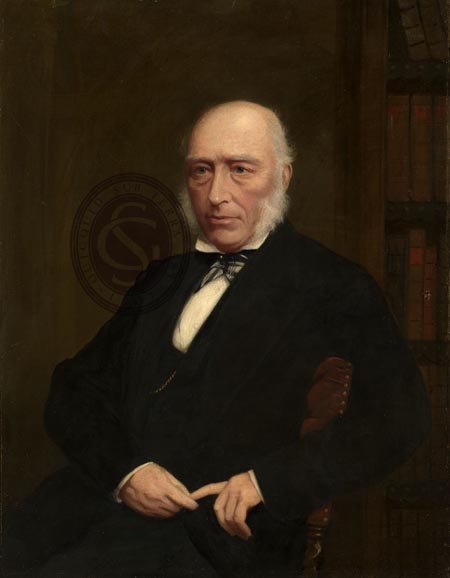Portrait of John Phillips (1800-1874)

|
|
Portrait in oils of John Phillips, by unknown artist, [1874]. (GSL/POR/12).
Provenance: Presented to the Society by Henry Willett, 1875.
|
John Phillips was the nephew of William Smith, but became a renowned geological author, lecturer and curator in his own right.
After being orphaned at the age of seven he went to live with his maternal uncle who encouraged his scientific interests. From 1815 he trained under Smith as a land surveyor, later accompanying him on geological surveying trips around the country. When in 1824 the Yorkshire Philosophical Society invited Smith to lecture on geology, Phillips first aided, then co-lectured then finally broke out on his own as a solo speaker. His curatorial skills were also soon recognised, the Yorkshire Philosophical Society appointed him its keeper in 1825.
In 1834, Phillips moved to London where he was elected an FRS and appointed to the Chair of Geology at King’s College London. From there his career prospered, becoming the official palaeontologist to the Geological Survey in 1841, then Chair of geology and mineralogy at Trinity College Dublin in 1843. In 1853 he was appointed Deputy Reader of Geology at Oxford University, Reader in 1856 and finally the University’s second Professor of Geology in 1860. He was also Keeper of the Ashmolean Museum between 1854-1870, as well as keeper of the new University Museum from 1857 until his death.
Phillips took a more statistical approach to his uncle’s biostratigraphical theories, dismissing the concept of clearly defined geological systems emphasising instead three broader periods of past life - the ‘Palaeozoic’, ‘Mesozoic’ and ‘Cenozoic’ – terms which are still used to this day.
Unlike his uncle, Phillips was elected a Fellow of the Geological Society on 4 January 1828, serving on Council between 1853-1862, and as President, 1858-1860. He was awarded the Wollaston Medal in 1845.
Another portrait image, possibly of John Phillips, can be seen in our painting The British Association at Newcastle.